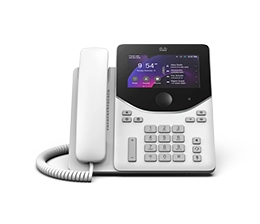UCaaS (Unified Communications as a Service) is a delivery model in which various communication and collaboration applications and services are outsourced to a third-party provider and delivered over an IP network, typically the Internet. This model encompasses voice, video, messaging, collaboration, and conferencing tools, providing a seamless communication experience across multiple platforms and devices. UCaaS offers businesses the flexibility to scale services according to their needs, reduces the complexity of managing communications infrastructure, and supports remote and mobile workforces by enabling access from anywhere at any time.
UCCaaS: An overview
UCCaaS extends beyond the traditional scope of Unified Communications as a Service (UCaaS) by incorporating enhanced collaboration tools into the communications platform. While UCaaS primarily focuses on integrating telephony, video conferencing, and messaging within one cloud-based solution, UCCaaS goes a step further to include comprehensive collaboration features such as project management tools, shared workspaces, and advanced file-sharing capabilities.
This holistic approach ensures that UCCaaS not only facilitates communication but also enhances teamwork by providing a suite of tools designed to streamline project coordination and team engagement. By breaking down silos and integrating various communication and collaboration functions, UCCaaS creates a more connected and synchronous work environment. The difference between UCaaS and UCCaaS lies in the latter's emphasis on collaboration, making it an ideal choice for enterprises that prioritize team-based work and projects.
UCCaaS advantages and applications
UCCaaS offers significant advantages that cater to modern business needs, emphasizing scalability, flexibility, secure collaboration, and more.
Scalability: UCCaaS platforms scale seamlessly with organizational growth. Specifically, this scalability means that businesses can add or remove users, features, and services as needed without the complexities and costs associated with traditional on-premises systems. This flexibility is particularly valuable for businesses experiencing rapid growth or seasonal fluctuations, ensuring that communication capacities align with current needs without excessive overhead.
Flexibility: The flexible nature of UCCaaS allows businesses to customize and configure their communication and collaboration environments to match their specific operational requirements. Whether it's integrating with existing workflows, third-party applications, or configuring settings to support diverse teams, UCCaaS provides the tools to create a tailored communication ecosystem that supports a variety of work styles and processes.
Simplified collaboration: UCCaaS combines various communication tools—such as video conferencing, unified messaging, file sharing, voicemail, and real-time co-editing of documents—into a single platform. This integration facilitates streamlined workflows and easier collaboration across different locations and departments. By breaking down barriers between communication modes, UCCaaS enables smoother project management and faster decision-making processes.
Support for remote work: UCCaaS is leveraged by organizations that adopt remote and hybrid work models. Its enterprise mobility capabilities offer employees the flexibility to connect from anywhere, on any device, with access to the same tools and resources via cloud-based unified communication tools. This capability not only helps in maintaining productivity but also aids in employee retention by supporting a more balanced and flexible working environment. Additionally, the cloud-based nature of UCCaaS ensures that updates and new features are rolled out simultaneously to all users, regardless of location—promoting uniformity and reducing IT complexity.
How businesses resolve common UCCaaS problems
When implementing a unified cloud communications solution, businesses often encounter a range of challenges that can hinder the full utilization of their new systems. From integration difficulties to user resistance and network instability, these issues require strategic solutions to ensure successful adoption and optimal performance.
Here's how businesses are tackling these common UCCaaS problems:
User adoption resistance: Resistance to adopting new technologies is common, particularly when they change familiar workflows or require users to learn new tools. This can slow down implementation and reduce the effectiveness of the new communication solutions. To address user adoption resistance to UCCaaS solutions, businesses can implement:
Structured training: Offer targeted training sessions tailored to different organizational roles to ensure all users are proficient with the new UCCaaS tools.
Change management: Provide intentional international communications about the benefits of UCCaaS, what changes to expect, and how these changes will support their work.
Pilot programs: Initiate pilot programs with a representative group of end-users before full-scale deployment. This approach helps identify potential issues early and allows for adjustments based on user reviews.
Feedback loops: Establish direct channels for users to provide feedback on their experiences with the UCCaaS platform. Use this feedback to make iterative improvements and address specific user concerns.
Network instability: Given that UCCaaS relies heavily on internet connectivity, any instability in the network can significantly impact the quality and reliability of communication services. This is particularly problematic for businesses with distributed teams or those in regions with less reliable internet services. Resolving this generally comes down to a mix of upgrading network infrastructure and implementing effective policies—and associated resources—for remote workers. Moreover, businesses can invest in redundant connectivity solutions, such as dual internet service providers (ISPs) and failover mechanisms, to ensure continuous service during outages.
Integration complexities: The challenge of seamlessly integrating UCCaaS solutions with existing IT systems and third-party applications is a frequent hurdle. This issue can disrupt workflows and data synchronization, making it difficult for organizations to maintain a smooth operational tempo. To resolve the integration complexities associated with UCCaaS solutions, organizations can adopt the following:
Use APIs: Employ application programming interfaces (APIs) to ensure seamless interactions between UCCaaS platforms and existing enterprise applications, facilitating smooth data flows.
Implement middleware: Deploy middleware to act as a bridge, helping to translate and manage data transactions between the UCCaaS system and other business systems.
Standardize data formats: Adopt common data formats and communication protocols—such as XML, JSON, REST, or SOAP, for example—to simplify integration across various platforms.
Leverage vendor tools: Utilize pre-built integration tools and adapters provided by UCCaaS vendors for popular enterprise systems, reducing the need for custom development.
To ensure seamless integration, Webex Contact Center offers pre-built connectors and robust APIs that align with a wide range of business applications and systems, including CRM tools like Salesforce, Microsoft Dynamics, and Zendesk. More generally, this solution allows organizations to maintain high levels of operational efficiency by ensuring that all team members—regardless of their location—can effectively access and utilize the same communication and collaboration tools.
Click here to learn more about how Webex Contact Center can optimize and simplify your customer service operations.










